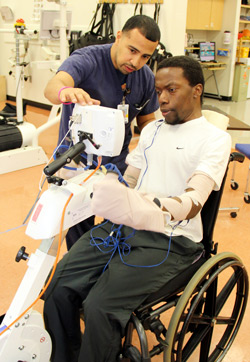
Born with Arnold-Chiari malformation, Taylor began to experience symptoms – weakness on the right side and headaches – when he was in high school. A neurological disorder of the cerebellum, the part of the brain that controls balance, Arnold-Chiari malformation occurs when parts of the cerebellum and brain stem are pushed downward into the foramen magnum, a funnel-like opening to the spinal canal, and into the upper part of the spinal canal. The result is pressure on the cerebellum that can affect functions controlled by this area of the brain and block the flow of cerebrospinal fluid (CSF) to and from the brain.
Diagnosed in 2008, Taylor has had neurosurgery every year since then for treatment of the disorder and related conditions. In July 2013, he suffered a cerebral hemorrhage in the left frontal lobe of the brain that left him with hemiplegia.
“Braxton was admitted to the Spinal Cord Injury Program because so many of his needs paralleled those of our cord injury patients, but in fact, he benefited from nearly every inpatient program we have,” says Adele Bosquez, PT, DPT, ATC, LAT, a physical therapist in the Spinal Cord Injury and Specialty Rehabilitation Programs. “In complex cases like Braxton’s, it truly takes an entire team.”
My main goal was to be able to walk and live more independently, and they threw everything they had at me.
Led by physical medicine and rehabilitation specialist Lisa Wenzel, MD, Taylor’s team included therapists, nurses, case managers and social workers who practice a unified, interdisciplinary approach to patient care. “I had big goals and worked hard to accomplish them,” says Taylor, who has completed three semesters at St. Mary’s University in San Antonio and plans to begin online courses to continue his education in the interim. “The team at TIRR Memorial Hermann was really good at helping me get there. My main goal was to be able to walk and live more independently, and they threw everything they had at me. The variety of equipment was very cool.”
Among the tools he worked with is the Bioness Vector Elite Gait and Safety System™, a harness support device that runs on a ceiling track, allowing him to practice walking over ground while his therapists gradually decreased the amount of his weight the device was carrying. “When patients are relearning how to walk, one of the significant barriers to progress is fear of falling,” says Matthew Davis, MD, clinical director of the Spinal Cord Injury Program. “The Vector takes away that risk and gives our staff the comfort and assurance that the patient is safe. It’s particularly useful for developing competency in patients with incomplete spinal cord injury and those like Braxton who have the potential to walk again.”
If this treatment is successful, persons with memory problems after TBI will experience improvements in day-to-day memory.
Taylor also benefited from other technologies, including the Hocoma Armeo® Spring, an ergonomic arm exoskeleton with integrated springs that enhances function and neuromuscular control; FES Bike, which applies small electrical pulses to paralyzed muscles to restore or improve their function; specially designed knee-ankle-foot orthoses (KAFOs) that stabilize the joints and assist the muscles of the leg; and an Ekso™ exoskeleton, a wearable bionic suit that enables individuals with lower-extremity weakness to stand and walk over ground to improve strength, mobility and endurance.
In occupational therapy, Taylor worked to improve his balance. “Braxton has good, strong core musculature, but his sense of balance is off,” says Bennett Cope, OTR. “We worked on finding his center of balance and realigning it, and later began working on functional tasks, such as dressing, eating and other activities of daily living. He’s a very, very smart kid with a strong work ethic. We could tell from day one that he was very practical in his approach to rehabilitation. He threw in ideas of his own and would never say no to anything we asked of him in a therapy session. I’d see him doing his homework after his sessions, and he worked with his nurses to stay on top of his care. When he was admitted, he was only able to take one or two bites of food unassisted. When he left, he could eat on his own.”
Taylor participated in TIRR Memorial Hermann’s community dining program, in which patients with spinal cord injury and others dine in a group at local restaurants to regain confidence. As part of the hospital’s community reintegration program, he attended an outing at the University of Houston focused on overcoming barriers to returning to school. He also joined FAME (Functional Arm Movement for Everyone), a program focused on increasing awareness and functional use of the impaired upper extremity.
“A social worker made sure he and his family were aware of other programs he qualified for,” Bosques says. “We helped him find transportation near home and gave him resource information for the Texas Department of Assistive and Rehabilitative Services.”
Cope and Bosquez worked with Taylor to find an appropriate wheelchair. “He didn’t want a power wheelchair because of the size and weight, but he didn’t have the strength to use a manual wheelchair,” Cope says. “We found the right manual chair for him and added a power function for maximum independence.”
A week before discharge, he participated in an in-house pass program that allowed his mother, Rosalyne Taylor, to stay with him for 24 hours to develop a hands-on understanding of the help he would need at home. “We’ve always had a good Spinal Cord Injury Program, and with all the technology we’ve added, we can offer our patients much more today than we could even a year ago,” Bosquez says.
Terree Funesti, RN, WCC, CRRN, clinical manager of the Spinal Cord Injury Unit, remembers Taylor as a “real gentleman who told his nurses every day how much he appreciated them. We really liked him, and like many young people, he fit into our unit like family. The beauty of rehabilitation nursing is that we see inpatients through their entire experience at the hospital. They come to us in such an acute condition and we help them gain their independence medically so they can get downstairs to the gym. Encouraging them to use the skills they learn in therapy and watching them transition from total assistance to independence is incredibly rewarding for us as nurses.”
Rhonda Abbott, PT, administrative director of therapy services and clinical programs, points to Taylor’s case as exemplary. “This is one of many cases in which we all pull together with the patient in unique, personalized ways to truly address function, community and meaningful participation,” she says. “We have the ability to do it all at TIRR Memorial Hermann, but what really makes us special is having creative therapists who can identify a young man’s needs and come up with a program designed to meet his specific goals. Making a difference in lives like Braxton’s and those who love him is where it’s at.”
Taylor says he’s come a long way in a relatively short period of time. “I walk with a walker and a little assistance to help with my balance issues,” he says. “I wouldn’t be where I am today without TIRR Memorial Hermann and my faith. They’re all great people to work with – motivating and very supportive.”
Contact Us
If you have questions or are looking for more information, please complete the form below and we will contact you.

Nationally Ranked Rehabilitation
For the 34th consecutive year, TIRR Memorial Hermann is recognized as the best rehabilitation hospital in Texas and No. 4 in the nation according to U.S. News and World Report's "Best Rehabilitation Hospitals" in America.
Learn More